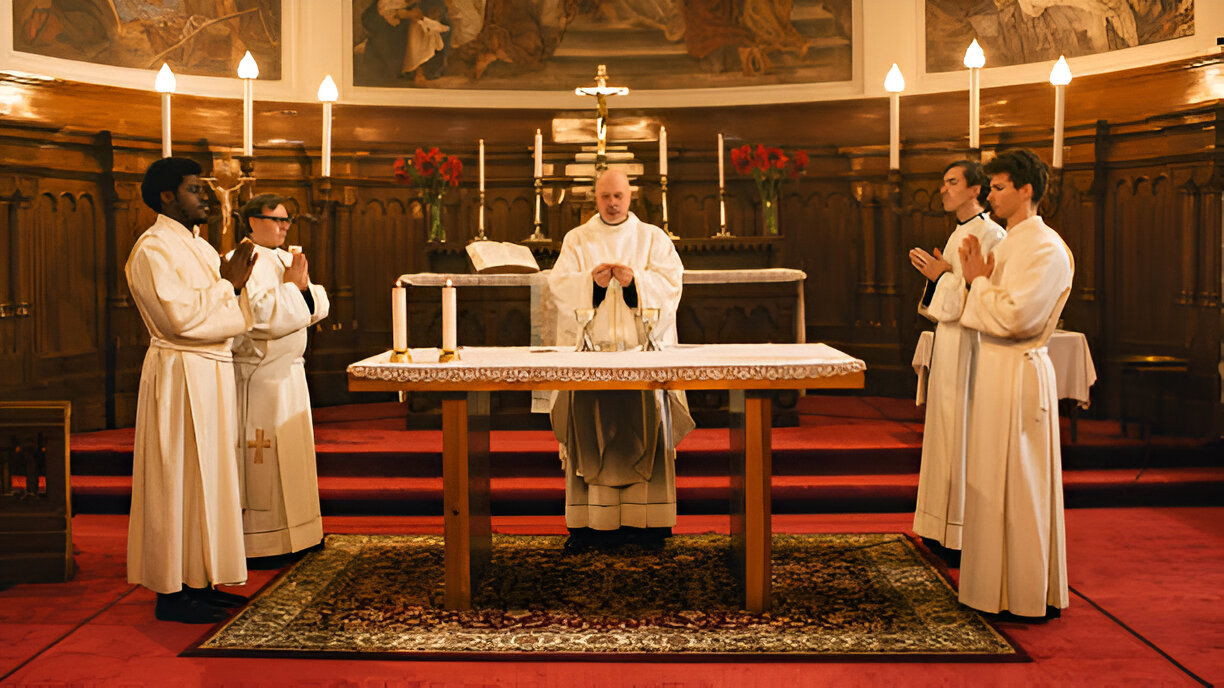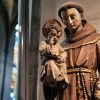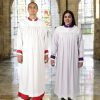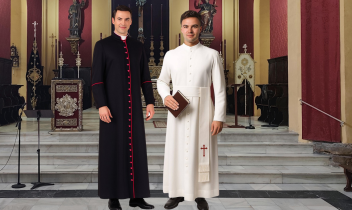No products in the cart.
Return To Shop
Priest Vestments and Their Colors
Priest vestments, with their rich, colorful garments, play a significant role in setting the tone for sacred celebrations like Mass or Good Friday services. Imagine a church during a grand Mass or a solemn Good Friday service. The priest steps forward, dressed in rich, colorful garments that draw your attention, setting the tone for the sacred celebration. The shimmering gold of Easter, the deep purple of Lent, and the fiery red of Pentecost all these colors are not merely decorative; they carry deep significance. When you think of the dress of a priest, the priest vestments and their colors are likely the first thing that comes to mind. From the soft white vestments worn during Christmas to the royal purple robes of Advent, each set of priestly attire reflects a message, a tradition, and a spiritual journey.
But what exactly do these colors mean? Why do priests wear certain colors for specific occasions? And how are these vestments crafted?In this article, we’ll explore everything you need to know about priest vestments colors, from their meanings to their importance in various Christian traditions. We’ll also delve into the different types of priestly vestments, when they are worn, and how to buy or even create them yourself. Whether you are interested in the Catholic vestment colors, Anglican vestments, or the rich history of these sacred garments, this guide has everything you need.
The Meaning Behind Priest Vestments Colors
Priest vestments are far more than just ceremonial garments; each color worn by a priest holds deep spiritual and liturgical meaning. Let’s explore the most commonly used Catholic priest vestment colors and their significance.
- White Vestments: White vestments are worn during celebrations of joy and purity, such as Christmas and Easter. The color symbolizes the victory of Christ over death and the light of the resurrection. Catholic vestment colors like white are also used during weddings, baptisms, and feasts of saints, symbolizing holiness and purity.
- Red Vestments: The fiery color of red is used to symbolize the Holy Spirit, martyrdom, and Pentecost. Red vestments meaning can be seen during celebrations of the Holy Spirit, such as Pentecost, and for the feasts of apostles and martyrs. Red also has strong associations with Christ’s passion and sacrifice, making it an important color during Good Friday vestments.
- Green Vestments: Green is the color of ordinary time, used in the liturgical calendar when there is no specific feast day or solemnity. Priest vestment colors in green reflect growth and hope, symbolizing the Christian journey of faith and the life of the Church. It’s the most common color seen throughout the year.
- Purple Vestments: Purple, or violet, is traditionally used during Advent and Lent, periods of penance and preparation. It symbolizes repentance, mourning, and the anticipation of Christ’s return. Purple vestments meaning is significant for occasions of solemnity, where reflection on the suffering of Christ is central.
- Rose Vestments: In Advent and Lent, rose vestments are worn on Gaudete Sunday (the third Sunday of Advent) and Laetare Sunday (the fourth Sunday of Lent). These Sundays are moments of joy and hope within the penitential seasons, symbolizing that the end of fasting is near.
- Black Vestments: Though not as commonly worn in recent times, black vestments are still used for funerals and for solemn occasions that emphasize mourning. The color reflects sorrow, but also hope in eternal life, symbolizing the priest’s role as a spiritual guide during times of grief.
Types of Priest Vestments
Priests wear a variety of sacred garments, each serving a specific function during Mass and other religious ceremonies. Let’s take a look at some of the key Catholic vestments for Mass and the names of the priest’s vestments:
- Chasuble vestment: The chasuble is the outermost garment worn by the priest. Its design and color reflect the liturgical season, and it’s worn during the celebration of Mass. The chasuble vestment is typically large and flowing, symbolizing the priest’s role as the one who brings the Eucharist to the faithful.
- Alb vestment: Underneath the chasuble, priests wear an alb, a long white garment symbolizing purity and the dignity of the priesthood. The alb vestment is worn by priests of all denominations and is typically paired with a cincture, a belt that keeps the alb in place.
- Stole vestment: The stole is a long, narrow strip of cloth worn around the neck and over the shoulders. It is a sign of the priest’s authority and office, and its color typically matches that of the chasuble. The stole vestment symbolizes the priest’s responsibility to care for the spiritual needs of the congregation.
- Cincture for vestment: The cincture is a cord or belt worn around the waist to secure the alb. It represents the priest’s readiness to serve God and the Church.
When and Why Priests Wear Specific Vestments
Priests wear different colors and types of vestments depending on the liturgical season, feast day, or occasion. Let’s explore when priests wear specific vestments for Mass or special events.
- Palm Sunday Vestments: On Palm Sunday, priests wear red vestments to symbolize Christ’s passion and the blood of martyrs. This day commemorates Jesus’ triumphant entry into Jerusalem, as well as his suffering leading up to his death on the cross.
- Good Friday Vestment Colors: On Good Friday, red vestments are traditionally worn to mark the bloodshed of Christ, although some churches still choose to use black vestments to signify mourning and the solemnity of the occasion.
- Advent and Lent Vestments: During Advent and Lent, priests wear purple vestments to reflect the penitential nature of these seasons. On the Sundays of these seasons, priests may wear rose-colored vestments, offering a moment of hope and joy amidst the periods of fasting and reflection.
- Christmas and Easter Vestments: During the festive seasons of Christmas and Easter, priests wear white vestments to celebrate the joy of Christ’s birth and resurrection. White symbolizes purity, light, and the glory of God.
Buying or Making Your Own Priest Vestments
Whether you are looking to purchase Catholic priest vestments for Mass, or if you wish to create your own, there are many options available. Stores like TrueFaith Vestments offer a wide variety of options, from traditional Catholic vestments to custom-made garments for specific liturgical needs. If you are a skilled craftsperson, you can even create your own vestments, either from patterns for priest vestments or by using pre-made Catholic vestment fabric. If you are interested in how to make vestments, there are plenty of resources online that can guide you through the process.
Conclusion
Priest vestments are far more than just clothing they are symbols of faith, authority, and tradition. From the meaning behind the colors of priest vestments to the specific Catholic priest vestments for Mass, these sacred garments reflect the deep spiritual significance of the liturgical calendar.
Understanding when and why certain priest vestment colors are worn can help you better appreciate the richness of the Catholic liturgical year and the roles these garments play in the life of the Church. Whether you’re looking to buy or create your own priest vestments, the options are endless, allowing you to wear these sacred garments with reverence and understanding.
Frequently Asked Questions (FAQs)
What are the names of the priest’s vestments?
The main vestments worn by a priest include the chasuble, alb, stole, and cincture.
What color vestments do priests wear on Easter?
Priests typically wear white vestments to celebrate the joy of Christ’s resurrection on Easter.
What is the significance of red vestments?
Red vestments symbolize the Holy Spirit, martyrdom, and the blood of Christ. They are worn on Pentecost and for feasts of apostles and martyrs.
Can I make my own priest vestments?
Yes, if you are familiar with sewing, you can create your own priest vestments using patterns and Catholic vestment fabric available online.
When do priests wear purple vestments?
Purple vestments are worn during the penitential seasons of Advent and Lent, symbolizing repentance and preparation for the coming of Christ.
Explore More About Priest Vestments
If you’re interested in purchasing high-quality priest vestments or learning more about how to craft your own, visit Holy Clergy today for a wide selection of traditional and custom options. Embrace the beauty and symbolism of priest vestments with garments that reflect your faith and commitment to tradition.








Recent Comments